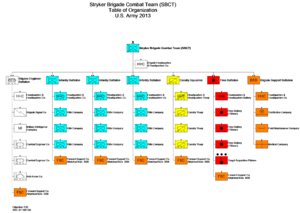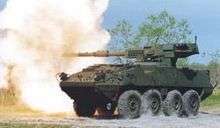Brigade combat team

The brigade combat team (BCT) is the basic deployable unit of maneuver in the US Army. A brigade combat team consists of one combat arms branch maneuver brigade, and its assigned support and fire units. "The Brigade is normally commanded by a Colonel (O-6) although in some cases a Brigadier General (O-7) may assume command."[1] A brigade combat team carries with its support units necessary to sustain its operations away from its parent division. BCTs contain organic artillery support, formerly received from the division artillery (DIVARTY).
Currently, the U.S. Army is structured around the brigade combat team.[2] In this program, divisions that previously had not deployed individual brigades due to lack of integral support have now been restructured. The 1st Armored Division, 25th Infantry Division, etc. now have the ability to deploy one or more BCTs anywhere in the world. These BCTs are intended to be able to stand on their own, like a division in miniature. The soldiers assigned to a BCT will stay at their assignment for three years; this is intended to bolster readiness and improve unit cohesion.
Infantry brigade combat team

The infantry brigade combat team, as of 2014, contains 4,413 soldiers and is organized around three battalions of infantry. Each type of brigade (light infantry, air assault, or airborne) has the same basic organization. Each infantry brigade is capable of air assault operations, whether or not it is officially designated as an air assault brigade. Also, most units typically maneuver in HMMWVs when deployed and operate as "motorized infantry" to facilitate speed of movement.
The infantry brigade combat team consists of seven battalions: one cavalry (RSTA), one brigade support, one engineer, three infantry and one field artillery.[2]
Infantry battalion (×3)
- Headquarters and headquarters company
- Rifle company (×3)
- Weapons company
Reconnaissance squadron
- Headquarters and headquarters troop
- Mounted reconnaissance troop (×2)
- Dismounted reconnaissance troop
Field artillery
- Headquarters and headquarters battery
- Target acquisition platoon
- M119 105mm towed howitzer battery (×2)
- M777A2 155mm towed howitzer battery (×1)
Brigade Engineer Battalion
- Headquarters and Headquarters Company
- Combat Engineer Company (×2)
- Signal network Support Company
- Military Intelligence Company
Brigade support battalion
- Headquarters and headquarters company
- Distribution Company
- Field Maintenance Company
- Medical Company
- Headquarters Platoon
- Treatment Platoon
- Medical Evacuation Platoon
- Forward Support Company (Reconnaissance)
- Forward Support Company (Engineer)
- Forward Support Company (Infantry) (×3)
- Forward Support Company (Field Artillery)
Stryker brigade combat team

The Stryker brigade combat team (SBCT) is a motorized infantry force structured around the Stryker eight-wheeled variant of the General Dynamics LAV III. A full Stryker brigade was intended to be C-130 Hercules air transportable into theatre within 96 hours, while a division-sized force is expected to need 120 hours. The Stryker brigade is an organic combined arms unit of lightly-armored, medium-weight wheeled vehicles, and is organized differently from the infantry or armored brigade combat teams. The Stryker brigades are being used to implement network-centric warfare doctrines, and are intended to fill a gap between the United States' highly mobile light infantry and its much heavier armored infantry. The BCT Ground Combat Vehicle Program was the planned successor of the interim armored vehicle before being cancelled in 2014. The team also receives training in chemical, biological, radiological and nuclear defense (CBRN defense).[3]
Each Stryker brigade combat team consists of three infantry battalions, one reconnaissance (cavalry) squadron, one fires (artillery) battalion, one brigade support battalion, one brigade headquarters and headquarters company and one brigade engineer battalion. A Stryker brigade is made up of more than 300 Stryker vehicles and 4,500 soldiers.[4]
Infantry battalion (×3)
- Headquarters and headquarters company
- Infantry company (Stryker) (×3)
Reconnaissance squadron
- Headquarters and headquarters troop
- Mounted reconnaissance troop (Stryker) (×3)
- Surveillance troop
Field artillery

- Headquarters and headquarters battery
- Target acquisition platoon
- M777A2 155mm towed howitzer battery (x 3)
Brigade support battalion
- Headquarters and headquarters company
- Distribution company
- Field maintenance company
- Medical company
- Forward support company (reconnaissance)
- Forward support company (engineer)
- Forward support company (infantry) (×3)
- Forward support company (field artillery)
Brigade engineer battalion
- Headquarters and Headquarters Company
- Combat Engineer Company
- Engineer Support Company
- Signal Company
- Military Intelligence Company
- Stryker Anti-tank Company
Stryker vehicles
- M1126 Infantry Carrier Vehicle
- M1127 Reconnaissance Vehicle
- M1128 Mobile Gun System armed with 105 mm overhead gun for direct fire
- M1129 Mortar Carrier armed with a mounted 120 mm and a dismountable 81 or 60 mm Mortar
- M1130 Command Vehicle
- M1131 Fire Support Vehicle (FSV) with targeting and surveillance sensors
- M1132 Engineer Support Vehicle (ESV)
- M1133 Medical Evacuation Vehicle (MEV)
- M1134 Anti-Tank Guided Missile Vehicle (ATGM) armed with a twin TOW missile launcher.
- M1135 Nuclear, Biological, Chemical, Reconnaissance Vehicle (NBC RV)
Armored Brigade Combat Team

The armored brigade combat team is the army's primary armored force. It was designed around combined arms battalions that contain both M1 Abrams tanks and M2 Bradley infantry fighting vehicles (IFVs). Other vehicles, such as HMMWVs and variants of the M113 armored personnel carrier, operate in a supporting role. In the future, it will also contain vehicles from the Future Fighting Vehicle and the Armored Multi-Purpose Vehicle.
An armored brigade combat team consists of seven battalions: three combined arms, one cavalry (reconnaissance), one artillery, one engineer and one brigade support battalion. As of 2014, the armored brigade combat team is the largest brigade combat team formation with 4,743 soldiers. Prior to 2012, the armored brigade combat team was named the heavy brigade combat team.[2]
An ABCT includes 90 Abrams tanks, 90 Bradley IFVs, and 112 M113 vehicles. The operational cost for these combat systems is $66,735 per mile. The range of the Abrams limits the brigade to 330 km (205 miles), requiring fuel every 12 hours. The brigade can self-transport 738,100 L (195,000 gallons) of fuel, which is transported by 15 5,000-gallon M969A1 tankers and 48 2,500-gallon M978 tankers.[5]
Combined Arms Battalion (×3)
- Headquarters and headquarters company
- Tank company (×2)
- Mechanized infantry company (×2)
Cavalry Squadron
- Headquarters and headquarters troop
- Reconnaissance troop (×3)
Field Artillery Battalion
- Headquarters and headquarters battery
- Target acquisition platoon
- M109 155mm self-propelled howitzer battery (x3)
Brigade Engineer Battalion
- Headquarters and headquarters company
- Military intelligence company
- Signal network support company
- Combat engineer company (×2)
Brigade Support Battalion
- Headquarters and headquarters company
- Distribution company
- Field Maintenance company
- Medical company
- Headquarters platoon
- Treatment platoon
- Medical evacuation platoon
- Forward support company (Cavalry)
- Forward support company (Combined Arms) (×3)
- Forward support company (Field Artillery)
- Forward support company (Combat Engineer)
Modernization
The U.S. Army plans to implement elements of the BCT Modernization program in 2010. This program utilizes elements from the Future Combat Systems Program that was canceled in early 2009.
The program comes in two segments. The first to be implemented would be the Early Infantry Brigade Combat Team Capability Package (Early IBCT Package), which would modernize infantry brigade combat teams. The second to be implemented would be the Follow-on Incremental Capability package, which could modernize all brigades.
Downsizing
After the 2013 reform's round of de-activations and downsizing, the below numbers represent the number of BCTs that will be left in the US Army's Active Component. (Numbers after the brigade re-organization in brackets)
Combat brigades: 45 (32)[6][7][8][9]
- 17 (10) armored brigade combat teams
- 8 (8) Stryker brigade combat teams
- 10 (6) infantry brigade combat teams
- 6 (5) infantry brigade combat teams (airborne)
- 4 (3) infantry brigade combat teams (air assault)
In July 2015, the Army announced the reduction of 2 additional BCTs as part of ongoing reductions to an endstrength of 450,000. In addition to the reduction, one active Stryker BCT will convert to an infantry BCT, and its vehicles will be used to convert an Army National Guard BCT from armored to Stryker. After the reductions, the 30 active BCTs will be composed of:[10]
- 9 armored brigade combat teams
- 7 Stryker brigade combat teams
- 7 infantry brigade combat teams
- 4 infantry brigade combat teams (airborne)
- 3 infantry brigade combat teams (air assault)
National Guard brigade combat teams have same TOE as active army BCTs. Total of 28 National Guard BCTs.
- 6 armored brigade combat teams
- 2 Stryker brigade combat teams
- 19 Infantry brigade combat teams
- 1 infantry brigade combat team (mountain)
See also
- British Army Future Army Structure (Next Steps), for comparison
- 256th Infantry Brigade Combat Team (United States)
- MOWAG Piranha derived vehicles used by other forces
- Transformation of the United States Army
- United States Army
- Regimental combat team
- USMC Marine Air-Ground Task Force, for comparison
Notes
- ↑ https://www.army.mil/info/organization/unitsandcommands/oud/ Organization: Operational Unit Diagrams:Brigade. Accessed 22 October 2016.
- 1 2 3 "MCOE Supplemental Manual 3-90" (PDF). U.S. Army. September 2013. Retrieved April 20, 2014.
- ↑ Limardo, Jessica (February 12, 2014). "Army unit trains to handle CBRNE threats". BioPrepWatch. Retrieved April 20, 2014.
- ↑ Ashton, Adam (February 17, 2014). "Stryker crews find ways to defeat armored enemy". Stars and Stripes. Retrieved April 20, 2014.
- ↑ Abrams Dieselization Project: Doing the Math - Defensemedianetwork.com, 7 November 2013
- ↑ http://www.army.mil/article/106373/Brigade_combat_teams_cut_at_10_posts_will_help_other_BCTs_grow/
- ↑ "Archived copy". Archived from the original on 1 January 1970. Retrieved 2014-08-26.
- ↑ http://www.armytimes.com/story/military/2015/07/01/2nd-infantry-division-anniversary-korea-brigade-inactivation/29562787/
- ↑ http://www.stripes.com/news/2nd-id-unit-in-korea-to-deactivate-be-replaced-by-rotational-force-1.312557
- ↑ http://www.armytimes.com/story/military/pentagon/2015/07/09/army-outlines-40000-cuts/29923339/
References
- FM 3–20.96 Reconnaissance and Cavalry Squadron
- FM 3–21.20 The Infantry Battalion
- FM 3–90.6 Brigade Combat Team
- FM 3–90.61 The Brigade Special Troops Battalion